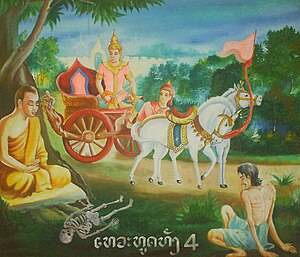Four sights
The four sights (Skt. caturnimitta; P. catunimitta; T. mtshan ma bzhi; C. sixiang) are four encounters in the life of Siddhartha Gautama (the future Buddha) which led to his realization of the impermanence (anitya) and the ultimate dissatisfaction of conditioned existence. According to traditional accounts, before these encounters Siddhārtha had been confined to his palace by his father, who feared that he would become a religious mendicant (śramaṇa) if he came into contact with sufferings of life. However, on his first venture out of the palace, these four encounters affected him deeply and made him realize the sufferings of all beings. These encounters eventually compelled him to begin his spiritual journey, which eventually led to his enlightenment.
Traditional account of the four sights
Background
After the birth of Siddhartha Gautama, his father King Śuddhodana called upon eight Brahmins to predict his son's future. While seven of them declared that the prince would either be a Buddha or a great King, the Brahmin Kaundinya was confident that Siddhartha would renounce worldly life and become a Buddha.[1]
Śuddhodana, who was determined that his son should be a great king, confined the prince within the palace and surrounded him with earthly pleasures and luxury, thereby concealing the realities of life that might encourage him to renounce these pleasures and become a religious mendicant (śramaṇa).[2]
Observing the sights
After leading a sheltered existence surrounded by luxury and pleasure in his younger years, Prince Siddhārtha ventured out of his palace for the first time at the age of 29.[2][3] He set off from the palace to the city in a chariot, accompanied by his charioteer Channa.[4]
On this journey he first saw an old man, revealing to Siddhārtha the consequences of aging.[5] When the prince asked about this person, Channa replied that aging was something that happened to all beings alike.[4]
The second sight was of a sick person. Once again, the prince was surprised at the sight, and Channa explained that all beings are subject to illness or disease (vyādhi). This further troubled the mind of the prince.[4]
The third sight was of a dead body. As before, Channa explained to the prince that death (maraṇa) is an inevitable fate that befalls everyone.[4] After seeing these three sights, Siddhārtha was troubled in his mind and sorrowful about the sufferings that have to be endured in life.[6]
After seeing these three negative sights, Siddhārtha came upon the fourth sight, a religious mendicant (śramaṇa) who had devoted himself to finding the cause of human suffering.[7] This sight gave him hope that he too might be released from the sufferings arising from being repeatedly reborn, and he resolved to follow the mendicant's example.[3][4]
Aftermath
After observing these four sights, Siddhārtha returned to the palace, where a performance of dancing girls was arranged for him. Throughout the performance, the prince kept on thinking about the sights. In the early hours of morning, he finally looked about him and saw the dancers asleep and in disarray. The sight of this drastic change strengthened his resolve to leave in search of an end to the suffering of beings.[8][9]
After this incident and realizing the true nature of life after observing the four sights,[3] Siddhārtha left the palace on his horse Kanthaka, accompanied only by Channa. He sent Channa back with his possessions and began an ascetic life, at the end of which he attained enlightenment as Gautama Buddha.
References
- ↑ Keown, Damien; Hodge, Stephen; Tinti, Paola (2003). A Dictionary of Buddhism. Oxford University Press. p. 15. ISBN 0-19-860560-9.
- ↑ 2.0 2.1 "A Young People's Life of the Buddha by Bhikkhu Silacara". AccessToInsight. Retrieved 2014-07-18.
- ↑ 3.0 3.1 3.2 McFaul, Thomas R. (2006). The future of peace and justice in the global village. Greenwood Publishing Group. pp. 30, 31. ISBN 0-275-99313-2.
- ↑ 4.0 4.1 4.2 4.3 4.4 Trainor, Kevin (2004). Buddhism. Oxford University Press. ISBN 0-19-517398-8.
- ↑ Mehrotra, Chandra; Wagner, Lisa (2008). Aging and Diversity. CRC Press. p. 344. ISBN 978-0-415-95214-9.
- ↑ "Siddhartha Gautama". Washington State University. Archived from the original on April 3, 2008. Retrieved 2009-04-29. Unknown parameter
|url-status=ignored (help) - ↑ Cooler, Richard. "Buddhism". Center for Southeast Asian Studies, Northern Illinois University. Retrieved 2009-04-29.
- ↑ Easwaran, Eknath (2007). The Dhammapada. Nilgiri Press. ISBN 1-58638-020-6. (see article on book)
- ↑ Gach, Gary (2001). The complete idiot's guide to understanding Buddhism. Alpha Books. p. 8. ISBN 0-02-864170-1.
| This article includes content from Four sights on Wikipedia (view authors). License under CC BY-SA 3.0. |
